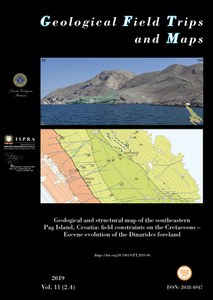Geological and structural map of the southeastern Pag Island, Croatia: field constraints on the Cretaceous - Eocene evolution of the Dinarides foreland
The sedimentary succession exposed in the Northern Dalmatia Islands mainly consists of Cretaceous to Neogene shallow water carbonates, folded and imbricated within the External Dinarides thrust belt. During Cretaceous times, carbonate sediments were deposed on a heterogeneous, tectonically-influenced carbonate platform, which was then uplifted and eroded, as evidenced by a regional unconformity embracing the Late Cretaceous and Paleocene. Sedimentation resumed during the Eocene, when the area was part of the foreland basin of the Dinaric belt. With our geological and structural map of the southeastern Pag Island at the 1:25,000 scale, we refined the stratigraphic and structural setting and the tectono-sedimentary evolution of the area.
DOI: 10.3301/GFT.2019.06

